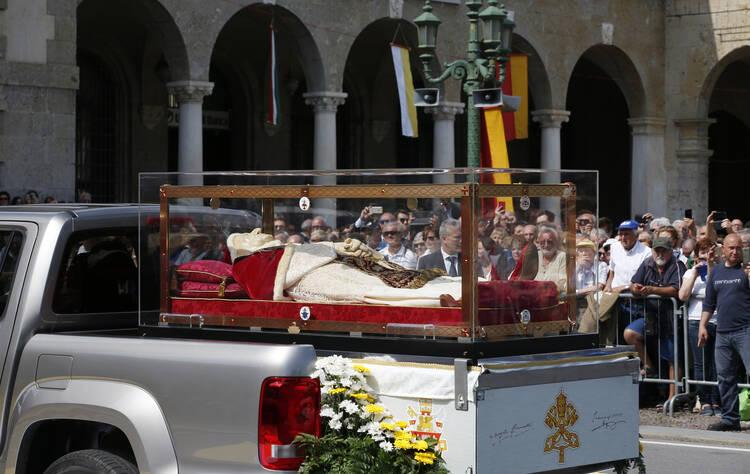BERGAMO, Italy (CNS) — Accompanied by Bishop Francesco Beschi of Bergamo and escorted by both Italian and Vatican police officers, the glass coffin containing the body of St. John XXIII left the Vatican early on May 24 for a 370-mile drive to Bergamo.
The route taken for the trip north was kept secret for security reasons.
When the procession reached Bergamo's central Vittorio Veneto Square, Bishop Beschi told thousands of people gathered there that it was "with great joy and emotion that I accompanied to our diocese, our city, the urn with the mortal remains—now relics—of John XXIII, which return for a few days to the land of his birth."
St. John, who opened the Second Vatican Council, was born on Nov. 25, 1881, in Sotto il Monte, a town near Bergamo. After his ordination as a priest and years of service in the Vatican diplomatic corps, he was appointed patriarch of Venice in 1953. He was elected pope on Oct. 28, 1958, and died five years later.
The pilgrimage with his remains was meant to mark the 60th anniversary of his election and the 55th anniversary of his death.
Maria Calagari was in the square with her sister and some friends to welcome St. John's remains.
"We are fortunate because we saw him when he was pope, we saw him die and we just saw him now—55 years later as a saint here in Bergamo," she said. "We are fortunate."
In connection with the pilgrimage of St. John's relics, Pope Francis gave an interview to L'Eco di Bergamo, the area's main daily newspaper, which is owned by the Diocese of Bergamo.
In the interview, Pope Francis described St. John as "a saint who did not know the word 'enemy,'" but "always sought what would unite people."
For St. John, he said, "the church is called to serve human beings, not just Catholics, and to defend always and everywhere the rights of the human person and not just of the Catholic Church."
Pope Francis said the pilgrimage was meant to be "a gift and an occasion" to renew one's faith and to remember the great pope. It is a special opportunity for the elderly, the sick and the poor, who have not been able to go to St. Peter's Basilica to pray at his tomb.
The visit to the Diocese of Bergamo included a stop at the city's prison, where 180 prisoners—including 35 Muslims—asked permission to enter the internal courtyard where a truck carrying the remains was to stop.
The prison yard was the first place in Bergamo where people were allowed to touch the glass coffin. The prisoners were given a square of either yellow or white fabric to touch to the glass; most of them touched the glass with their hands, then used the fabric to wipe the glass clean.
Vincenza, one of the inmates, told the local television station that it was amazing to have the saintly pope's remains stop in the prison at the beginning of the pilgrimage "because usually, especially for important events, prisoners are the last ones people think about."
From the prison, the relics were to be driven to the diocesan seminary named after Pope John XXIII. The priests of the diocese were to escort the remains to the cathedral later in the day.
Teens and young adults of the diocese planned a prayer vigil in the cathedral on May 25, and the remains were also to be present the next morning as new priests were ordained for the diocese.
After a Mass with the poor on May 27, the body was to be moved to the hospital named after the late pope, then transferred to the Shrine of St. John XXIII in Sotto il Monte.
Pilgrims can pray before the saint's remains at the shrine until June 10, when Cardinal Pietro Parolin, Vatican secretary of state, will celebrate Mass and the body will be returned to the Vatican.
Cardinal Angelo Comastri, archpriest of St. Peter's Basilica, told Vatican Media that "this is the first time—it's never happened before—that the remains of a pope make a return visit to his home, to his roots."
- - -
Contributing to this story was Cindy Wooden at the Vatican.









I have read your an excellent article, it is very informative and helpful to me Packers And Movers Wakad